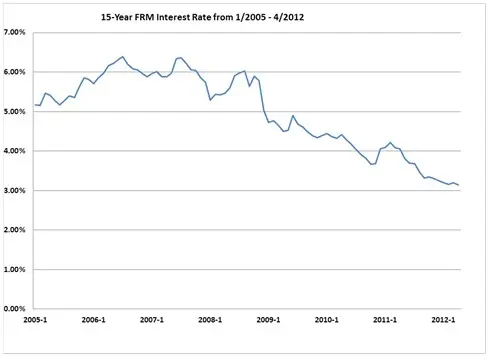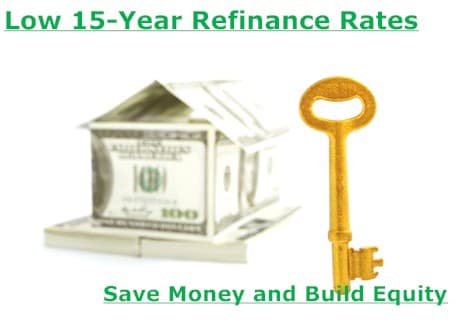- 15-Year refinance mortgage rates are at all time lows.
- Pay off your loan quickly and cheaply.
- Shop around and compare rates.
15-Year Refinance Rates - Lower Financial Costs and Build Equity Faster
Mortgage rates hit historic lows in 2012. A 15-year mortgage rate offers both low interest and stable payments, allowing you to reduce your financial costs and pay off your mortgage faster.
Quick Tip #1
Although interest rates are similar for purchase mortgage loans and refinance loans, borrower profiles and goals are different. If you are looking for a purchase loan, then read the Bills.com article about 15-year FRM mortgage interest rates.
If your goals include lowering your interest rate and reducing costs, then this is an excellent time to consider refinancing into a 15-year loan. If you are considering refinancing for other reasons, including lowering your monthly payment, then read about 30-year FRM refinance loans and interest rates.
In order to help you decide if a 15-year mortgage is your best option, start by shopping around for the best 15-year mortgage rate. Make sure that you learn about:
- 15-Year Refinance Rates - Historic Low
- Today’s Mortgage Rates
- Comparison of Monthly Payments
15-Year Refinance Rates - Historic Low Rates
Recent studies have shown that many borrowers who are refinancing their homes are looking for a 15-year fixed mortgage rate. This is due to three reasons:
- The 15-year fixed interest rate is at all-time lows in 2012.
- By setting a shorter period, with the lower interest rate, your monthly payments do not increase significantly.
- You pay-off your loan much build equity in your house much faster. If you decide to move, you will be in a stronger equity position, and far less likely to need to have to sell your home with a negative equity problem.
The chart below shows historical data for 15-Year FRM Interest rates, from 1/2005 to 4/2012, based on Freddie Mac's Primary Mortgage Survey:

Today’s Mortgage Rates
Here are real rates offered by Bills.com lenders. You can compare the 15-year rate to other products that offer either lower payments, or a more risky payment structure.
Comparison of Monthly Payments
Due to today’s low 15-year fixed refinance rates, many borrowers can refinance into a lower interest rate, with a monthly payment comparable to their current mortgage, and cut years off their mortgage.
Here is an example to show how you can refinance into a 15-year loan and only increase your payments marginally. Let’s assume that your original loan was a 30-year FRM for $280,000, 5.75% interest rate, and a monthly payment $1,634. After 7 years, you wish to refinance the remaining balance of $250,000:
| Original Loan | 15-Year Refinance | |
|---|---|---|
| Term | 23 year | 15 years |
| Interest Rate | 5.75% | 2.75% |
| Monthly Payment | $1,635 | $1,697 |
| Total Remaining Interest Payments | $201,249 | $55,380 |
You pay only $62 more per month, but pay off your loan 8 years sooner, saving about $146,000 in interest costs. Since there are costs associated with refinancing, make sure that the amount of time you are staying in the house is long enough to make refinancing worthwhile. Assuming fees and closing costs of 2%, it would take only 8 months to break even.
In order to qualify for a 15-year mortgage, lower your interest rates, and pay off your mortgage loan more quickly, make sure that you have:
- An excellent FICO score
- A low DTI ratio
- Sufficient equity in your house.
Shop around and remember to compare interest rates and fees. Make sure that your payment schedule meets your financial situation and level of acceptable risk. A 15-Year FRM is a good option if you want a stable, low-interest rate mortgage and have the financial capability to meet the monthly payment.
Quick tip #3
do you want to save on your financial costs? do you have a good steady cash flow? then get a mortgage refinance quote for the best 15-year and other mortgage refinance loans from a bills.com mortgage provider.
